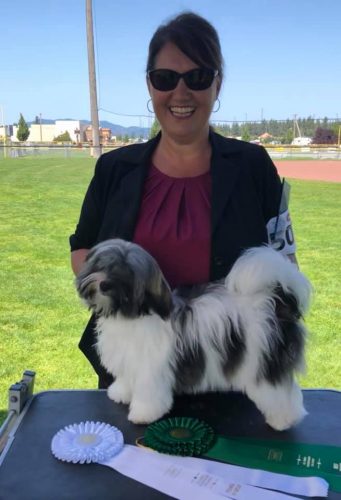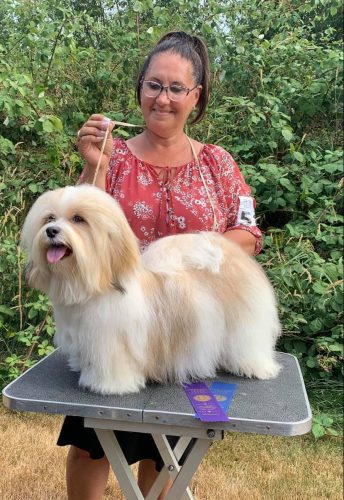HAVANESE DOG BREED PROFILE
The Havanese is a gentle and very affectionate breed that thrives on human companionship. This adorable breed boasts the distinction of being the Cuban national dog breed. Although the Havanese is new to the AKC and CKC, the breed has been in existence in its native Cuba for centuries as a treasured family pet, bred to play with children in the courtyards of aristocratic Cubans. Through the years, the Havanese has been bred for companionship. It’s gorgeous, good looks and endearing personality make the breed a wonderful house pet. The Havanese is a VERY social animal that treats all with a friendly welcome. Like every dog, the Havanese needs early socialization. Our team works hard when raising pups to make sure we are stimulating and socializing them with those living in our homes. We expose them to different sounds and experiences . Our belief is this will help your Havanese puppy grow up to be a well-rounded dog. The Havanese is a hypoallergenic Toy breed, and usually ranges in height from 8 to 12 inches and weighs from 7 to 16 pounds. He has large, dark, and appealing eyes. The non-shedding coat is long, soft, straight to wavy, and like human hair, is odorless when wet. The breed comes in a rainbow of colors, from white to shades of cream, champagne, gold, black, blue, silver, chocolate, or any combination of these. The plumed tail is carried over the back.
Because the Gene pool of this rare breed is small, be sure to view pedigrees to make sure the dog is bred well.
This breed is truly, the trendiest, friendliest, and popular companion breed of our era.
The CKC has an information sheet on the “Breed Standard” that can be seen at: www.ckc.ca/en/Portals/0/pdf/breeds/HVN.pdf
Havanese dogs need up to 30 minutes of exercise per day. Rule of thumb: use your dog’s size as a basis for their required exercise. Havanese are small-medium sized dogs. They have a medium energy level and does not need much exercise, unlike bigger dogs. Large yards are not needed since they will stay where the companion is.
It is good to bring them out for two or three short walks daily. It will also help their socialization skills if kept around people like in parks or city walks. This will help keep them fit and healthy. Aside from walks, in-house games and playtime can also act as exercise so there will be an interaction that they love.
Origin & Purpose: The breed comes from the Western Mediterranean region and has developed along the Spanish and Italian coastal region. These dogs were imported early to Cuba by sea captains. Erroneously, the most frequent brown colour of these dogs (tobacco) gave birth to the legend which would mean it to be a breed originating from Havana, capital of Cuba. Political events led to the total disappearance of the old bloodlines of the Havanese in Cuba; apparently a few dogs were successfully smuggled out of Cuba whose descendants have survived in the U.S.A.
Temperament: Loving and make an excellent companion. Exceptionally bright, very easy to train. Affectionate, of a happy nature, he is amiable, a charmer, playful and even a bit of a clown. Havanese love children and will play endlessly with them. (Non-Yappy Breed, Not a heavy Barker)
General Appearance: The Havanese is a sturdy little dog, low on his legs, with long abundant hair, soft and preferably wavy. His movement is lively and elastic. (90% of Companion Havanese owners, keep their dogs in a puppy cut)
Size: A normal adult Havanese dog will reach its optimal size by the age of 6 to 8 months old but will generally mature at the age of 1 year old. Height at the withers from 9-10.6 inches (23-27 cm). Tolerance from 8-11.4 inches (21-29 cm). (weight are seen ranging from 7-22lbs, we strive to breed 8-12lbs) Mini, Pocket, or Teacup Havanese are the terms used to lure people in. However, the Canadian Kennel Club testified that the dog does not come in different size variants. They added that the only acceptable length for a standard full grown Havanese should be between 21 to 29 cm. We ONLY BREED to the standard and do not believe in designer breeds.
Coat: Hair: undercoat woolly and not very developed; it is often totally absent. The Havanese is famous for their silky floss hair which is very lightweight. They have a strong double coat. The topcoat is exceedingly long 5-7 inches (12-18 cm in adult dog), soft, flat, or wavy and may form curly strands. The usage of scissors to even out the length of the coat and all trimming is forbidden. Exception: tidying up the hair on the feet is permitted, the hair on the forehead may be slightly shortened so that it does not cover the eyes and the hair on the muzzle may be slightly tidied up, but it is preferable to leave it in natural length.
Colour: there are two varieties of colour. Rarely completely pure white; fawn in its different shades of light fawn to Havana-brown (tobacco colour, reddish brown); patches in those colours of coat; slight blackened overlay admitted. Permissible colours and patches (white, light fawn to Havana-brown) with black markings. Black coat.
Head: Of medium length, the relation between the length of the head and that of the trunk (measured from the withers to the base of the tail) is 3/7. Skull: flat to very slightly rounded, broad; forehead rising; seen from above it is rounded at the back and almost straight and square on the other three sides. Stop: moderately marked. Nose: black. Muzzle: narrowing progressively and slightly towards the nose but neither snippy nor truncated. Lips: fine, lean, tight. Jaws/Teeth: scissors bite. A complete dentition is desirable. The absence of premolars 1 (PM1) and molars 3 (M3) is tolerated. Cheeks: very flat, not prominent. Eyes: quite big, almond shape, of brown colour as dark as possible. Kind expression. The eye rims must be dark brown to black. Ears: set relatively high; they fall along the cheeks forming a discreet fold which raises them slightly. Their extremity is in a lightly rounded point. They are covered with hair in long fringes. Neither propeller ears (sticking sideways), nor stuck to the cheeks.
Neck : Havanese have a slightly arched neck that blends smoothing into the shoulders. If measured, the body from shoulders to buttocks should be longer then the height at the withers. f medium length
Forequarters: Forelegs straight and parallel, lean; good bone structure. The distance from the ground to the elbow must not be greater than that between the elbow and the withers.
Body: The length of the body is slightly superior to that of the height at the withers. Topline straight, slightly arched over the loin. Croup noticeably inclined. Ribs well sprung. Belly well tucked up.
Hindquarters: Good bone structure; moderate angulations. Feet of slightly elongated shape; small; tight toes.
Tail: Carried high, either in shape of a crozier or preferably rolled over the back; it is furnished with feathering of long silky hair.
Gait: According to his happy nature, the Havanese has a strikingly light-footed and elastic gait; forelegs with free stride and pointing straight forward, the hind legs giving them the impulsion and moving in a straight line.
Faults: Any departure from the foregoing points should be considered a fault and the seriousness with which the fault should be regarded should be in exact proportion to its degree.
- General appearance lacking in type
- Truncated or snippy muzzle, length not identical to that of the skull
- Bird of prey eyes; eyes too deep set or prominent; rims of eyelids partially depigmented
- Body too long or too short
- Straight tail, not carried high
- French front (pasterns too close, feet turned outwards)
- Deformed hind feet
- Coat harsh, not abundant; hair short except on puppies; groomed coat
- **NOTE** showing a dog in a Corded Coat is NOT a fault.
Disqualification
- Depigmented nose
- Upper or lower prognathism (overbite or underbite)
- Ectropion, entropion; rim of eyelids of one or both eyes depigmented
- Size over or under the indicated norms of the standard
- Male animals should have two apparently normal testicles fully descended into the scrotum. A retained testicle is a DQ.
Havanese dogs are great companions because they live a long, happy, and healthy life. There are factors that should be considered when breeding Havanese dogs and buying from a reputable breeder. Make sure that everything has been discussed, like possible health conditions.
Regularly visit a vet to keep their health in check. The Havanese is a good breed since they are not as demanding like others but mostly need companionship above all.
At Wyntr’Gems Havanese we breed to better the breed, we breed quality over quantity. Our vet records are open and we are happy to share all our parents OFA health records. For more information or if you have questions, please contact us at wyntrgems@shaw.ca and Yvette would be happy to talk with you.


